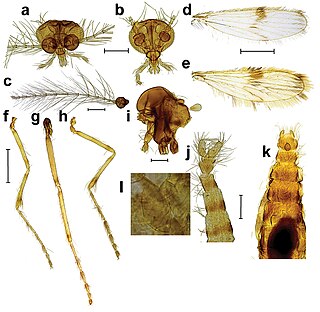
Ceratopogonidae is a family of flies commonly known as no-see-ums, or biting midges, generally 1–3 millimetres in length. The family includes more than 5,000 species, distributed worldwide, apart from the Antarctic and the Arctic.

Psychodidae, also called drain flies, sink flies, filter flies, sewer flies, or sewer gnats, is a family of true flies. Some genera have short, hairy bodies and wings, giving them a "furry" moth-like appearance, hence one of their common names, moth flies. Members of the sub-family Phlebotominae, which are hematophagous, may be called sand flies in some countries, although this term is also used for other unrelated flies.

Culicoides is a genus of biting midges in the family Ceratopogonidae. There are over 1000 species in the genus, which is divided into many subgenera. Several species are known to be vectors of various diseases and parasites which can affect animals. The genus has a long fossil record, with earliest known fossils being from Burmese amber, around 99 million years old.

The Wessex Formation is a fossil-rich English geological formation that dates from the Berriasian to Barremian stages of the Early Cretaceous. It forms part of the Wealden Group and underlies the younger Vectis Formation and overlies the Durlston Formation. The dominant lithology of this unit is mudstone with some interbedded sandstones. It is part of the strata of the Wessex Basin, exposed in both the Isle of Purbeck and the Isle of Wight. While the Purbeck sections are largely barren of vertebrate remains, the Isle of Wight sections are well known for producing the richest and most diverse fauna in Early Cretaceous Europe.

Paleoparasitology is the study of parasites from the past, and their interactions with hosts and vectors; it is a subfield of paleontology, the study of living organisms from the past. Some authors define this term more narrowly, as "Paleoparasitology is the study of parasites in archaeological material." K.J. Reinhard suggests that the term "archaeoparasitology" be applied to "... all parasitological remains excavated from archaeological contexts ... derived from human activity" and that "the term 'paleoparasitology' be applied to studies of nonhuman, paleontological material." This article follows Reinhard's suggestion and discusses the protozoan and animal parasites of non-human animals and plants from the past, while those from humans and our hominid ancestors are covered in archaeoparasitology.

Corethrellidae are a family of biting midges, small flying insects belonging to the order Diptera, females of which feed on the blood of frogs. The members of the family are sometimes known as frog-biting midges. The family currently consists of just one genus, totalling 115 extant and 10 fossil species worldwide. Most extant species are found in the lower latitudes, usually associated around the tropics.

Corethrella is a genus of midges that are classified in the family Corethrellidae.

Diamesinae is a subfamily of midges in the non-biting midge family (Chironomidae).

Leptoconops is a midge genus in the family Ceratopogonidae. It has a mostly tropical or subtropical distribution worldwide, but some species occur as far north as Moscow region in Russia and the Yukon Territory in Canada.

New Jersey Amber, sometimes called Raritan amber, is amber found in the Raritan and Magothy Formations of the Central Atlantic (Eastern) coast of the United States. It is dated to the Late Cretaceous, Turonian age, based on pollen analysis of the host formations. It has been known since the 19th century, with several of the old clay-pit sites now producing many specimens for study. It has yielded a number of organism fossils, including fungi, plants, tardigrades, insects and feathers. The first identified Cretaceous age ant was described from a fossil found in New Jersey in 1966.
Leptoconops zherikhini is an extinct species of biting midges belonging to the family Ceratopogonidae. This species was described from fossilized remains preserved in Lower Cretaceous amber from Álava, Spain. These fossils represents the earliest known occurrence of extant genus Leptoconops.

Leptoconops nosopheris is an extinct species of biting midges belonging to the family Ceratopogonidae. This species was described from fossilized remains preserved in Burmese amber from the Early Cretaceous. The amber containing the fossil was mined in the Hukawng Valley, in Kachin State, Myanmar
Leptoconops gravesi is an extinct species of biting midge belonging to the family Ceratopogonidae. This species was described from fossilized remains preserved in Late Cretaceous amber from Vendée, France. The piece of amber containing the holotype specimen also preserved a scelionine wasp and an earwig nymph.
Leptoconops amplificatus is an extinct species of biting midge belonging to the family Ceratopogonidae. This species was described from fossilized remains preserved in Lower Cretaceous amber from Lebanon.
Leptoconops antiquus is an extinct species of biting midges belonging to the family Ceratopogonidae. This species was described from fossilized remains preserved in Lower Cretaceous amber from Lebanon.
Leptoconops burmiticus is an extinct species of biting midges belonging to the family Ceratopogonidae. This species was described from fossilized remains preserved in Burmese amber from the Lower Cretaceous. The amber containing the fossil was mined in the Hukawng Valley, Myanmar.
Leptoconops rossi is an extinct species of biting midges belonging to the family Ceratopogonidae. This species was described from fossilized remains preserved in Burmese amber from the Lower Cretaceous. The amber containing the fossil was mined in the Hukawng Valley, Myanmar.

Dungeyella is an extinct genus of chironomid midge from the Wealden amber of the Wessex Formation of the Isle of Wight, UK, containing the single species D. gavini. it belongs to the subfamily Buchonomyiinae.
2015 in paleoentomology is a list of new fossil insect taxa that were described during the year 2016, as well as other significant discoveries and events related to paleoentomology that were scheduled to occur during the year.
This paleoentomology list records new fossil insect taxa that were described during the year 2014, as well as notes other significant paleoentomology discoveries and events which occurred during that year.










